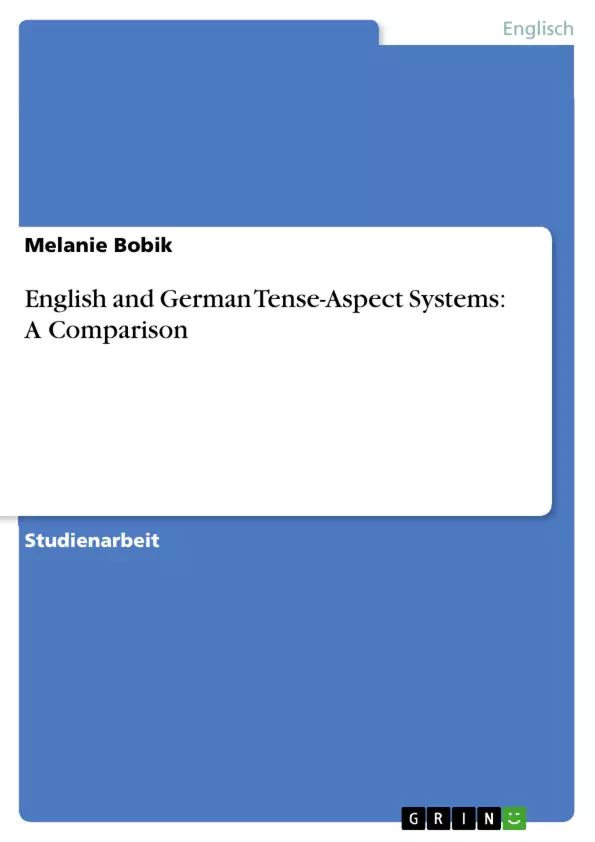Within the last two decades many attempts have been made to define a generally accepted concept of universal temporal and aspectual systems. There are comprehensive studies about the grammatical functions of tense and aspect, their categories and their meaning. In regard to their tense systems, English and German show amazing parallels in the inventory of forms but there are major differences in their use and function.
The following paper gives an overview of English and German tense and aspect systems and presents traditional and current theories and controversies on them. Moreover, an attempt will be made to discuss in detail function and use of the perfect, future and progressive construction in these two languages.
Inhaltsverzeichnis
- 1. Introduction
- 2. Time in Order
- 3. Defining Tense
- 3.1. Concepts of Temporal Relations
- 3.2. Tense in English
- 3.3. Tense in German
- 4. Defining Aspect
- 4.1. Grammatical Aspect - Perfective vs. Imperfective
- 4.2. Aktionsart
- 5. A Comparison of English and German Tense-Aspect-Systems
- 5.1. Characterising The Perfect
- 5.2. Future Time Reference in English
- 5.3. Future Time Reference in German
- 5.4. The Progressive
Zielsetzung und Themenschwerpunkte
Dieses Dokument analysiert die Zeit- und Aspekt-Systeme des Englischen und Deutschen, untersucht die Gemeinsamkeiten und Unterschiede zwischen den beiden Sprachen und präsentiert traditionelle sowie aktuelle Theorien und Kontroversen zu diesen Themen. Insbesondere wird die Funktion und Verwendung der Perfekt-, Futur- und Progressivkonstruktionen in den beiden Sprachen detailliert diskutiert.
- Definition und Funktion von Tempus und Aspekt in Englisch und Deutsch
- Analyse des Perfekts im Englischen und Deutschen
- Untersuchung der zukünftigen Zeitreferenz in Englisch und Deutsch
- Analyse der Progressivkonstruktion in Englisch und Deutsch
- Vergleich der Zeit- und Aspekt-Systeme des Englischen und Deutschen
Zusammenfassung der Kapitel
1. Introduction
Der Text beleuchtet die Entwicklung eines allgemein akzeptierten Konzepts von universellen Zeit- und Aspekt-Systemen in den letzten Jahrzehnten. Er stellt fest, dass Englisch und Deutsch, trotz ihrer ähnlichen Formen, signifikante Unterschiede in der Verwendung und Funktion ihrer Tempus-Systeme aufweisen. Das Dokument bietet einen Überblick über die Zeit- und Aspekt-Systeme der beiden Sprachen, diskutiert traditionelle und aktuelle Theorien und untersucht detailliert die Funktion und Verwendung des Perfekts, Futurs und Progressivkonstruktionen.
2. Time in Order
Das Konzept der Zeit wird anhand eines Diagramms erläutert, welches Ereignisse vor und nach dem gegenwärtigen Moment 0 positioniert. Es werden verschiedene Mittel zur zeitlichen Lokalisierung von Ereignissen vorgestellt: lexikalische Ausdrücke, lexikalische Elemente und grammatische Kategorien.
3. Defining Tense
Der Text definiert Tempus als grammatischen Ausdruck der Zeit der Situation, die in einem Satz beschrieben wird, relativ zu einem anderen Zeitpunkt. Dieser andere Zeitpunkt kann der Zeitpunkt der Äußerung sein. Er diskutiert die Definition von Tempus und die verschiedenen Konzepte von zeitlichen Beziehungen, die von Linguisten entwickelt wurden, insbesondere Reichenbachs Konzept von Temporalrelationen, das zwei Hauptmerkmale beinhaltet: die Beziehung zwischen dem Zeitpunkt der Äußerung (TU), dem Zeitpunkt des Ereignisses (TSit) und dem Bezugspunkt (R), sowie die Analyse der Verwendung von Tempus in Englischen und Deutschen.
4. Defining Aspect
Dieses Kapitel definiert Aspekt als die grammatische Kennzeichnung der Art und Weise, wie ein Ereignis in der Zeit abläuft. Es werden die verschiedenen Typen von Aspekt, wie z.B. perfektiver und imperfektiver Aspekt, sowie die Aktionsart, die beschreibt, wie ein Verb ein Ereignis in der Zeit darstellt, erörtert.
5. A Comparison of English and German Tense-Aspect-Systems
Dieses Kapitel vergleicht die Zeit- und Aspekt-Systeme des Englischen und Deutschen, indem es die Verwendung des Perfekts, der zukünftigen Zeitreferenz und der Progressivkonstruktion in den beiden Sprachen untersucht.
Schlüsselwörter
Die zentralen Themen dieses Textes sind Zeit, Aspekt, Tempus, grammatische Kategorien, Englisch, Deutsch, Perfekt, Futur, Progressiv, Aktionsart und die Vergleichende Sprachwissenschaft. Der Text betrachtet die verschiedenen Konzepte von Tempus und Aspekt, die in den beiden Sprachen verwendet werden, und analysiert ihre Bedeutung und Funktion in verschiedenen Kontexten. Der Text bietet einen umfassenden Überblick über die Zeit- und Aspekt-Systeme des Englischen und Deutschen.
- Citar trabajo
- Magister Artium Melanie Bobik (Autor), 2003, English and German Tense-Aspect Systems: A Comparison, Múnich, GRIN Verlag, https://www.grin.com/document/68009



